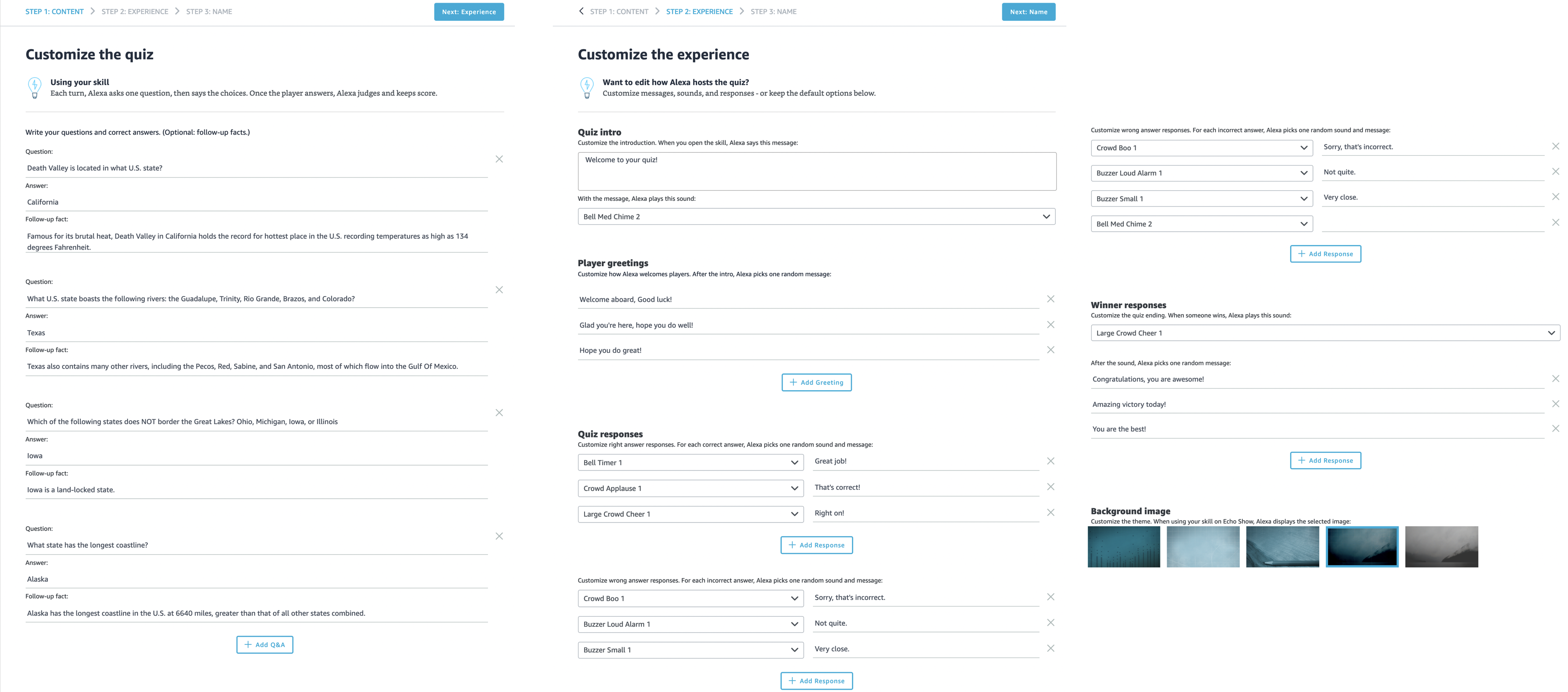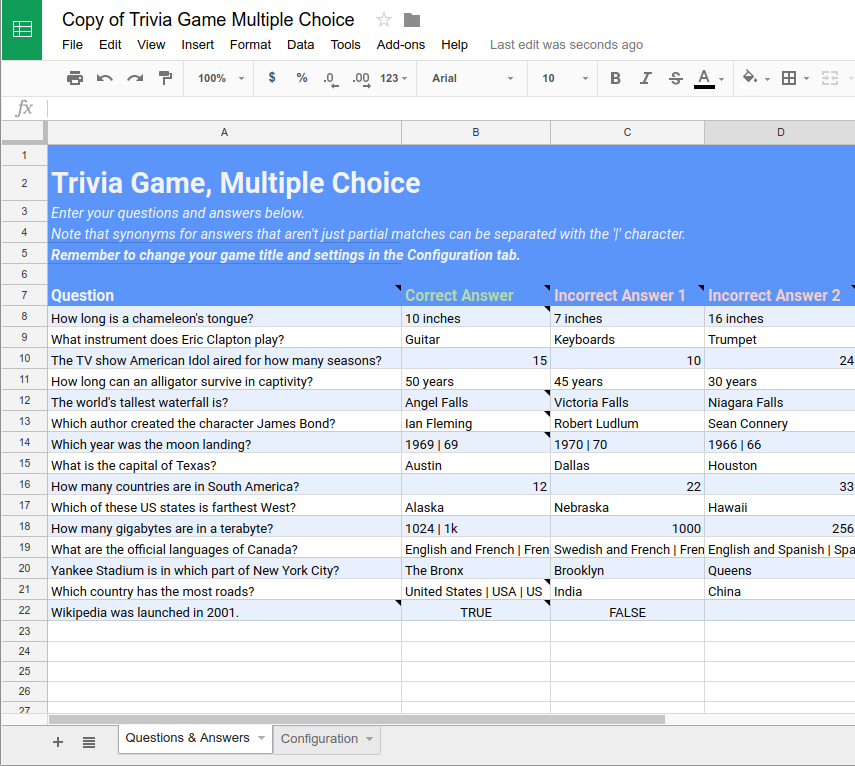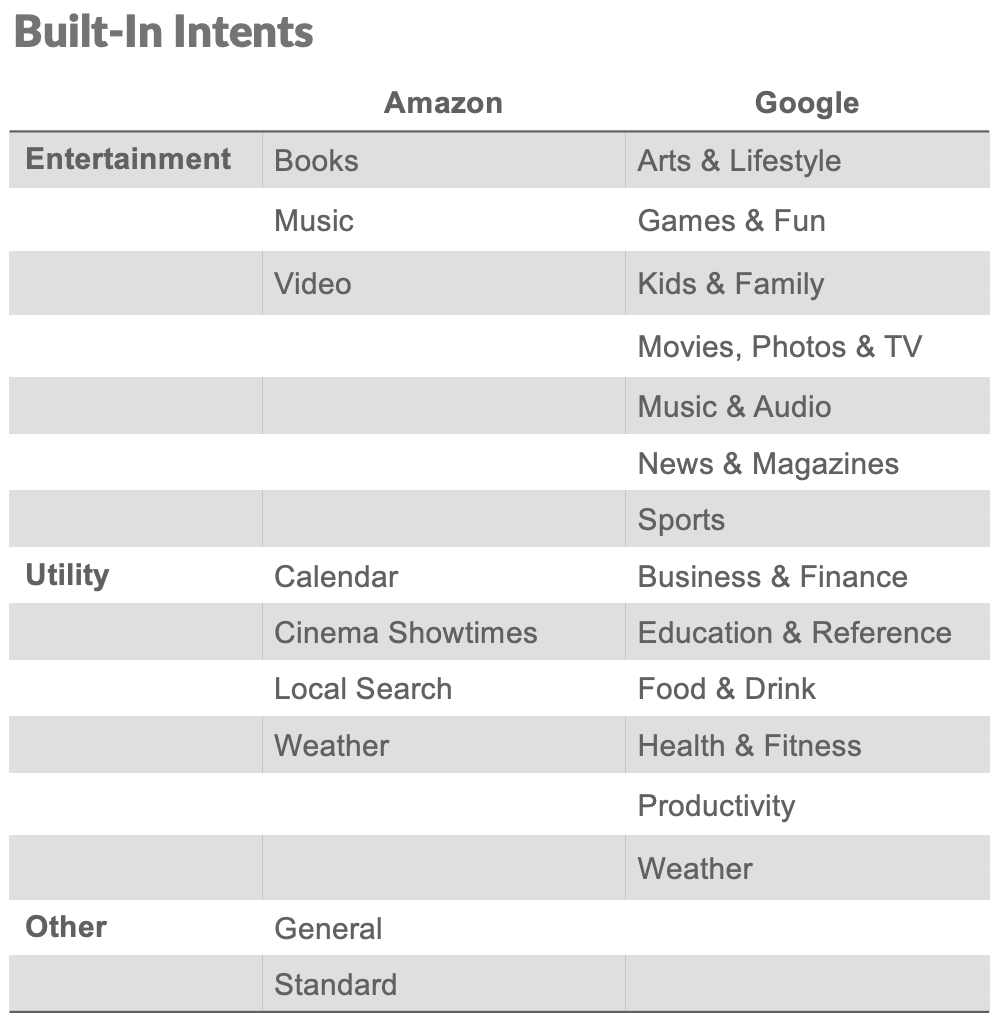We have done extensive research on which smart speaker is best. The ability to understand users, correctly answer their questions, and deliver responses in natural sounding speech is usually summed up by one word: intelligence. The IQ of the assistant inside is the predominant factor that makes one smart speaker stand out over another. As the number and diversity of voice-assistant enabled devices continue to grow, developers who build skills on their platforms are a second audience that is becoming increasingly important to the two biggest players in the space: Google and Amazon.
Though developers have different goals than consumers when choosing a platform, what they are looking for can also be summed up by one word: opportunity. How quickly they can get started, what resources a company makes available, and how easy it is to get their skill published and benefit from its usage all contribute to a platform’s opportunity.
The interest in smart speakers and devices continues to rise. An estimated 26% of the US population now owns at least one smart speaker, up from 16% in 2017. As voice assistants continue to offer more utility and fulfill more complicated use cases, demand will keep rising. A platform’s ability to capture developer’s interest and incentivize them to build more functionality into their assistant will be crucial in capitalizing on growing smart device adoption.
Our goal is to evaluate both Amazon Alexa and Google Assistant on the opportunities they offer to both experienced developers and people just starting to explore the possibilities. After developing several skills on both, here are what we think the advantages each platform has over the other are and what these differences tell us about their voice-assistant strategy.
Getting Started
Resources
Starting development on both platforms is easy and they each have an abundance of resources. On the homepage of the Amazon Alexa Developer site, it is immediately apparent that Amazon has created a wide variety of resources to help get started. This includes webinars, training courses, guides, the Alexa Developer Blog, Tutorials, Alexa Events, Alexa on Twitch, Alexa Dev Chat Podcast, and tools to find agencies that can develop skills. Part of this is a list of third-party tutorials. The downside of this much information is that it can be difficult to know exactly where to get started. Google on the other hand, provides clear tutorials in their Codelabs (a series of tutorials they have for several different products). Codelabs provide a consistent experience across all Google platforms. Continuity across documentation for all Google services makes getting started with a new one much less overwhelming. The Codelabs walk through the same project at three different levels of difficulty, each adding more functionality to the last. For the first skill, it was easier to get started on Google. After that, Amazon provides more resources and the Alexa blog gives help with more complicated topics.
Cloud Integrations
There is an abundance of ways to leverage both companies’ cloud resources. When getting started, it can be difficult to figure out how to take advantage of all the different possibilities. They both detail how to host your code with web services but miss an opportunity to include tutorials of increasing complexity to show off how useful they can be. Part of their assumption may be that if people are interested in that route, they will already know what they need. However, skills work as a great way to demonstrate to both enterprise and casual clients how powerful their web services are and excite them about possibilities they might not know about. This is the one area where both could use improvement.
Developer Credit
Since the code to run skills/actions needs to be hosted in the cloud, for early-stage developers it is important to have cost-effective options or people will be discouraged from creating them.
Both companies offer free trials of Cloud services and extra credit from developing skills. After trials expire, both have options to get cloud credit up to a certain amount. For smaller developers they will likely provide enough for their usage as the cap is very high. The takeaway is both companies want creating skills and running them to be free.
In summary, Amazon and Google both have good documentation and helpful guides. In this comparison neither pulls ahead.
Developing
Amazon and Google aim to keep the barrier to entry as low as possible. Both companies have powerful tools to create skills without needing to program so users can further customize their assistants. This provides a great way to excite people about creating skills, encourage new developers, and enable skills that would otherwise be tedious to configure through voice (for example setting up a chore chart).
Codeless Skills
In this area, Amazon has the advantage with Alexa Blueprints, their approach to skill templates that require no programming. The process for them is very simple, and they provide a quick summary of what the skill does and its components. They have all the categories pre-filled as an example. Below is an example of what this looks like for a quiz skill.

Google’s implementation uses Google Sheets. While this is useful, it only lends itself to creating skills that lookup or store information. The three categories they have are Trivia, Personality Quiz, and Flash Cards. The currently available Blueprints offer a much more diverse range of skills. Below is an example of what this looks like for a trivia game.

One can add more columns to the Questions & Answers tab for more options (such as difficulty level and topic) and then customize skill behavior in the Configuration tab.
To make voice assistants an increasingly useful part of people’s daily routines, allowing customization and skill creation without programming is important. They both face the challenge of making more people aware of these features. In this regard, Google has a slight advantage because you can create actions with your Google account. While Google currently has less diversity, using spreadsheets does lend itself to the three types of skills they have, because many will already have that information stored in a spreadsheet and it is easy to copy over. Even though Amazon’s UI is better, any piece of friction is likely to drive people off.
An opportunity for Amazon would be to allow people to create Blueprints from within the Alexa app. This would likely be difficult for them to implement but would be a great way to introduce people to Blueprints. Filling them out on the computer would be faster, especially for Blueprints like flashcards, but enabling customization within the app would be great exposure and possibly encourage more people to develop skills from scratch.
Built-in Intents
As the name suggests, Intents are the term both Google and Amazon use for what the user is trying to do. Put another way, they represent the functionality of the skill. Both platforms offer a variety of built-in intents. The benefits of using built-in intents vs creating custom ones are they already have the utterances that trigger them built in, it provides a consistent experience across skills (even from other developers), and Amazon or Google can improve their recognition so they become more natural to use over-time with no additional work for the developer.
What intents they offer gives insight into the types of skills they envision people creating or the types they want to incentivize people to create. The same applies to the APIs and SDKs they offer (which fall into the same categories below plus Smart Home). In this comparison, what is similar between the two instead of what is different is the most important.

Note: Many of Google’s intents in these categories are not yet released, but it still shows where their focus is.
While both have some inconsistency in scale of the category (Showtimes could be considered part of Local Search and some of Google’s Intents will be found in multiple categories) two patterns are clear. They both are trying to make it easier to build skills that focus on the Smart Home and consuming services (Music, Video, Books, News).
The focus on services and smart home is an angle they have both been pursuing aggressively. Content skills are probably the best opportunity for developers and one of the largest use cases for smart speakers. The platform that can best help users discover content and deliver it to them in the most seamless way will have an advantage.
Creative Content
After looking more into the tools available for developers to build service skills it became apparent that Google has a massive advantage for enabling content consumption due to the seamless integration possible between assistant, search, and device.
Content Discovery
Google has a variety of guides on how to make content discoverable by Assistant. Creators can go through steps so their content, such as a news feed, can be discovered by Assistant without the need to create a skill. This is a huge advantage, not only because time and money don’t need to be spent creating a skill to deliver a news feed for example, but also because this addresses one of the main issues with custom skills currently: discoverability. In cases where having a dedicated skill could be helpful, Google is sometimes able to auto-generate actions to deliver the content and auto-generate a listing page in the Assistant Directory. There is still a process to go through, but it should be much quicker than creating an action from scratch. Google Partners have even more options and can make their content discoverable by search and allow it to be initiated by assistant and opened in their app. Here are two examples from Google:
“Media Actions enable users to initiate media content (for example, songs, albums, movies) on content provider applications through Google Search and the Google Assistant. Here are some use cases:
- When a user issues a query for a movie on Google Search, Media Actions are shown in the Knowledge Graph card for the movie that appears in the results. A click on one of these Media Actions takes the user to the provider’s site or app to watch the content.
- When a user asks the Assistant to “play Lady Gaga” or “play Seinfeld”, the Assistant initiates playback of that content on the provider’s app.”
This is a good transition into their second advantage, which is how Assistant on mobile can be used to control content, something Alexa cannot compete with.
Content Control
Google also has a variety of SDKs and tools available to initiate or control content with Assistant. The Media Sessions API can be used so that people can control a Media app with assistant (allowing assistant to pause streamed music for example). This also highlights the advantage Google has from their app suite. Google Assistant can handle requests on the speaker and then send it directly to one of their apps on a user’s phone (such as directions to Google Maps for example).
Partnerships
Google is also actively pursuing partnerships to bring more complicated functions to Assistant. On their vertical integrations page, they are looking for partners to work with and create complicated tasks that Assistant can perform in almost every category. As an example, they have an upcoming feature where Assistant can check users into their flights. The possibility for Google to take on a lot of the development challenge and their ability to partner with a wider range of services, not just content, gives them an opportunity to create both experiences and perform complicated tasks through Assistant which Amazon will struggle to keep up with.
For these reasons, as a platform for both users and developers, Google has a massive advantage compared to Amazon going forward.
Conclusion
Breadth and depth are both important for a voice assistant to be dominant. Voice assistants need to be widely accessible and able to perform complicated tasks. The reach Google has from speaker and mobile combined with their ability to synergize upon the two for complicated use cases give them an advantage. Having been able to extend this to developers through a set of well documented APIs and SDKs shows how well they are leveraging this strength, and this will likely only get better with time. In our opinion, Amazon does have better tools for creating skills without code and also has easy-to-use APIs for content. They have both made what could be a very complicated process accessible. Comparing the options developers have for more complicated skills revealed the breadth and depth advantage Google has from integrating with a phone, the tools they have for developers to leverage this synergy, and their approach to partnerships. Creators of services have the most opportunity to benefit from assistants because they can drive traffic to their content and make it easier to consume. Currently, Google Assistant is more compelling for these creators.
Disclaimer: We actively write about the themes in which we invest or may invest: virtual reality, augmented reality, artificial intelligence, and robotics. From time to time, we may write about companies that are in our portfolio. As managers of the portfolio, we may earn carried interest, management fees or other compensation from such portfolio. Content on this site including opinions on specific themes in technology, market estimates, and estimates and commentary regarding publicly traded or private companies is not intended for use in making any investment decisions and provided solely for informational purposes. We hold no obligation to update any of our projections and the content on this site should not be relied upon. We express no warranties about any estimates or opinions we make.
